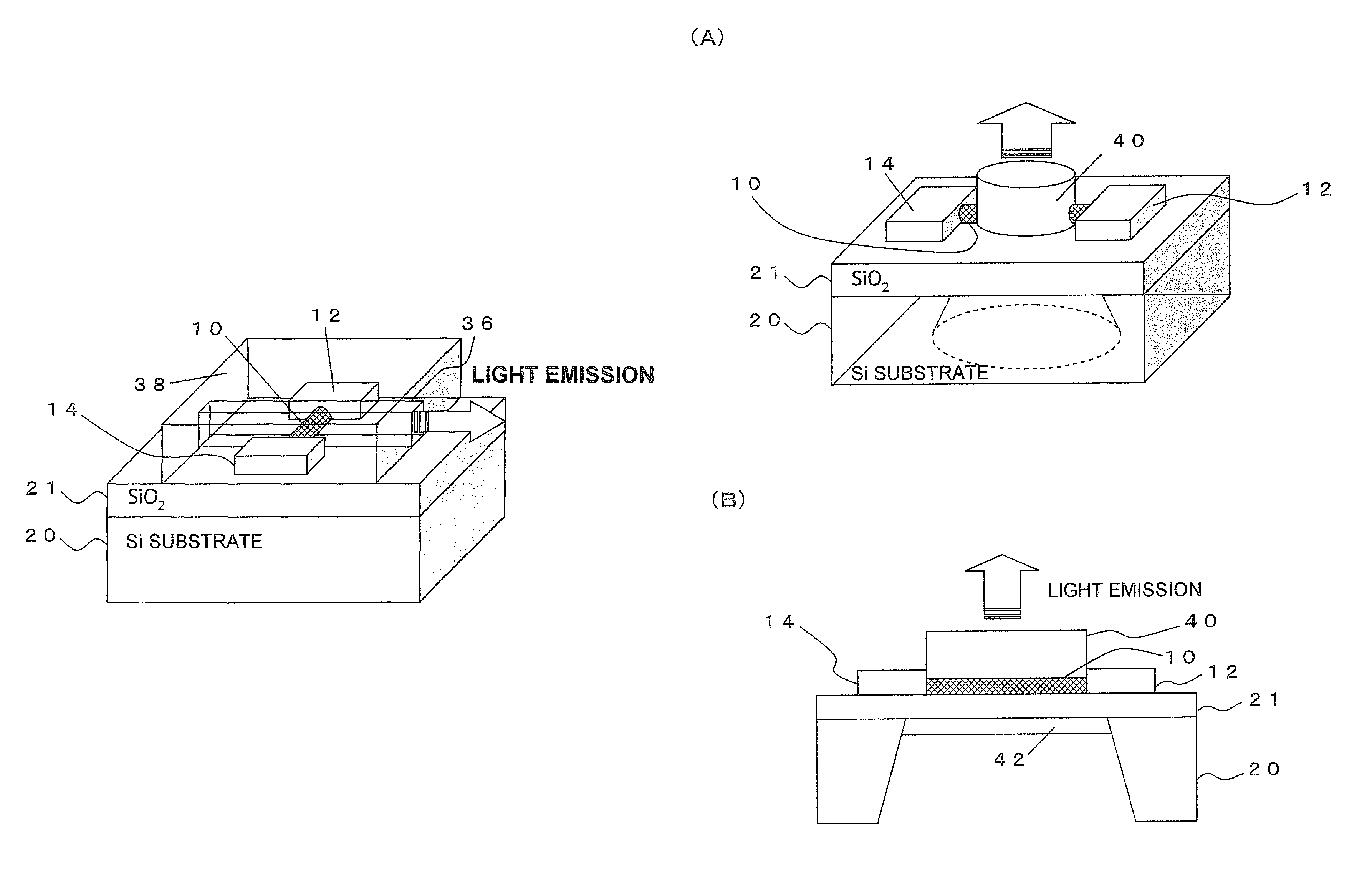Carbon nanotube light emitting device, light source, and photo coupler
a carbon nanotube and light-emitting device technology, applied in the field light sources and photo couplers, can solve the problems of inability to perform on-off modulation at high speed, research and development on high-speed modulation performance of carbon nanotube light-emitting devices had not been reported at all, and achieves high speed, easy fabrication, and high speed
- Summary
- Abstract
- Description
- Claims
- Application Information
AI Technical Summary
Benefits of technology
Problems solved by technology
Method used
Image
Examples
first embodiment
[0052]A light emitting device which is the present invention has an device configuration in which a source electrode 12 and a drain electrode 14 are formed for carbon nanotube thin films including one (one bundle of) metal carbon nanotube(s) or a plurality of metal carbon nanotubes (CNTs) 10 as shown in FIG. 2.
[0053]As a substrate 20, any kinds of substrates, such as Si, SiO2, Al2O3 and MgO substrates, may be used as long as a source-drain line is not electrically short-circuited. In the drawing, reference numeral 21 denotes a SiO2 film provided on the substrate 20.
[0054]The electrodes 12 and 14 may take any shape such as a rectangular shape. They may be formed into comb shaped electrodes to provide a larger emission area. The electrodes may be made of any materials such as metal and semiconductors as long as current can pass therethrough.
[0055]As shown in FIG. 2, the carbon nanotube 10 is disposed between the source electrode and the drain electrode. The carbon nanotubes disposed b...
second embodiment
[0061]In order to achieve long-time blackbody radiation, it is preferable to provide an insulating film 16, as seen in a light emitting device which is the present invention shown in FIG. 6, to prevent reaction with oxygen in the atmosphere. The insulating film 16 may be made of any materials such as oxide insulators including SiO2, SiN, SiON, Al2O3, MgO, HfO2, etc., and polymeric-material insulators including PMMA as long as the materials have insulation properties and can transmit light.
third embodiment
[0062]A description will now be given of a continuum spectrum light source which is the present invention adequately used as a light source incident to optical fibers.
[0063]As shown in FIG. 7, the present embodiment is configured such that a core 34 of an optical fiber 32 is pressed against a light emitting device similar to the first embodiment and is bonded thereto with adhesives such as PMMA and epoxy.
[0064]According to the present embodiment, light can efficiently be made to come incident into the core34 of the optical fiber 32.
PUM
| Property | Measurement | Unit |
|---|---|---|
| diameter | aaaaa | aaaaa |
| current | aaaaa | aaaaa |
| time- | aaaaa | aaaaa |
Abstract
Description
Claims
Application Information
 Login to View More
Login to View More - R&D
- Intellectual Property
- Life Sciences
- Materials
- Tech Scout
- Unparalleled Data Quality
- Higher Quality Content
- 60% Fewer Hallucinations
Browse by: Latest US Patents, China's latest patents, Technical Efficacy Thesaurus, Application Domain, Technology Topic, Popular Technical Reports.
© 2025 PatSnap. All rights reserved.Legal|Privacy policy|Modern Slavery Act Transparency Statement|Sitemap|About US| Contact US: help@patsnap.com



